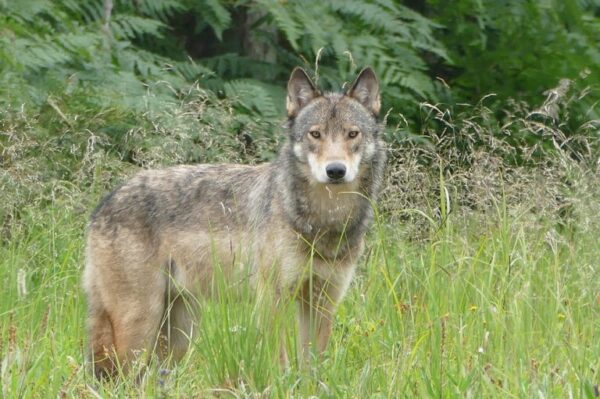
State game managers are pushing back on research that says Alaska’s predator control programs don’t work.
A paper by two retired state biologists and a University of Alaska Fairbanks professor says an analysis of harvest numbers in Game Management Unit 13 — that’s in Southcentral Alaska — showed moose harvests did not improve in the years following predator control.
The state disputes that finding, and Tom Paragi, a biologist with the Division of Wildlife Conservation, points to other research. Paragi says other studies back up the notion that predator control can help declining populations of prey, like moose.
Listen:
[Sign up for Alaska Public Media’s daily newsletter to get our top stories delivered to your inbox.]
The following transcript has been lightly edited for clarity.
Tom Paragi: What’s fairly common in the boreal region of Alaska, it was something shown in a landmark study that came out in 1992 by department staff, where they reviewed case studies of moose, 35 sites across Alaska and the Yukon, what they found is populations of moose declined to low abundance, which is typically less than about one per square mile, they can stay there and fluctuate a little bit from year to year in areas where the large predators, wolves and bears, remain at their natural densities. And what they found in some of those case studies is that where predators had been reduced through harvest or predator control, that allowed those moose populations to increase in abundance to more than one moose per square mile. And they would remain there. Once predator control stopped, they would remain there for a period of time. But over time, as the predators fell back into the area, increased to their prior abundance, and especially if you have done things like a severe winter that can, in turn cause a decline back down.
Casey Grove: I just want to be really clear, I mean, one thing that those researchers had said was that the state doesn’t have the scientific framework to back up the notion that predator control does work as intended. And it sounds like you’re saying that’s not true, that the state does have the scientific framework to back that up. Is that accurate?
TP: Yeah, the intensive management law came about in 1994. And at that point, there had been a couple decades of research in Interior, in Southcentral Alaska, that had looked at the effects of wolf and bear predation on moose and caribou populations. And they found that there are circumstances where, when prey populations get to some lower levels, predation can can hold them at those levels. And in terms of Unit 13, another thing that I looked at was, there were four sub units that had wolf control in them, and those are the ones that are driving this trend you saw on Unit 13, where the population was declining and harvest declined until the early 2000s, and after wolf control, they increased.
Now one question you might ask on that, is there another factor that may be led to the increase? One of the common things to look at is winter severity. And it turns out that winter severity has been comparatively mild since those predator control programs compared to historic periods. But an important thing is I also looked at two different moose survey areas nearby there, one a Unit 13 D, and one in Wrangell St. Elias National Park, which is east across the Copper River. And both those areas during the same period of the 1990s and well into around 2020, they were at low density, and they stayed at low density. So the areas that didn’t have wolf control stayed at low density. The four areas that did have wolf control increased in abundance, and they allowed more harvest of moose.
CG: Well, so Tom, I have to ask, you know, I’ve talked to the acting Director of the Division of Wildlife Conservation now, Ryan Scott and you, and it sounds like you just kind of reject this idea that this study puts forward, that predator control doesn’t work. And so, I mean, I guess I just have to ask, do you think that these researchers are just completely off base or what?
TP: The key thing to remember about intensive management or about predator management is it is very strongly driven by values, both for and against it by different members of the public. And science is not going to answer that question, the science behind the potential for predators to regulate prey at relatively low levels in boreal forest. It’s largely been shown over several decades, there’s probably close to 50 years of research now, that has shown there are situations where it can occur. That doesn’t mean that every situation is held low by predation, and there are some situations where predator management is not going to be feasible. The Board of Game, when, because of the intensive management law, the objectives that are set, they’re required to consider factors when prey populations get low, and then they have to restrict harvest. They’re required to consider different factors. But the law itself, the statute, describes situations where it may not be appropriate, and the board is not required to take action. And that’s due to scientific factors. For example, if you had very poor nutrition in an area for the prey population, and they would have little chance to grow even if you reduce natural predation, that’s one situation. Another one is land ownership. The Department of Fish and Game has not been doing predator control on national park or national wildlife refuge lands that are about 40% of the state. And the third reason is when it’s not in the best interest of subsistence users. And what that means is that if increasing the number of hunters in an area substantially is going to cause a lot of social conflict, that’s another reason the board is not does not have to implement a predator control program.
CG: I think, too, it’s probably worth mentioning those values, they essentially are aimed at providing hunters with an opportunity to put meat on the table, right?
TP: Absolutely. The intent behind the intensive management law is to increase harvest of moose, caribou and deer in areas where it’s important for human uses where it’s been documented through a long history of use. But the values, everybody weighs in on the values and it’s through the political process that those values get decided. But, you know, intensive management, any type of wildlife management, it can be science informed. The design of the programs can be based on science, as the intensive management programs are based on, like I said, decades of research showing that in certain situations, predation can limit them. But ultimately implementing those programs is a political decision. It’s a values decision. And the biologists try to stay out of those kinds of debates. That’s our role, is to provide the objective information so that all sides and all values can speak to what they think is appropriate to do.
Casey Grove is host of Alaska News Nightly, a general assignment reporter and an editor at Alaska Public Media. Reach him at cgrove@alaskapublic.org. Read more about Casey here.





